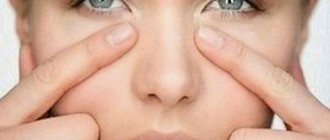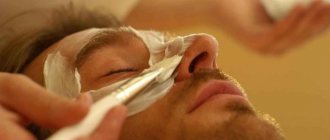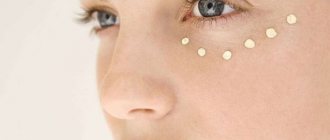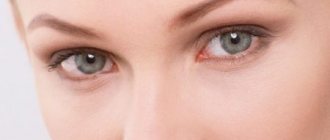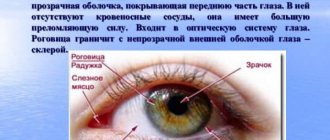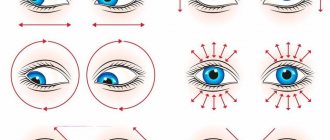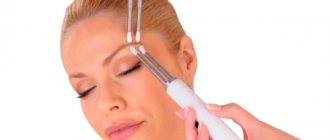Lifestyle influence
If you notice bruises under the eyes in men, before you assume some kind of disease and consult a doctor for treatment, you should pay attention to the person’s lifestyle. The appearance of dark circles is provoked by factors such as:
- 1. Night sleep. The first thing you should pay attention to is the duration of night sleep and the time it starts. In addition to the appearance of dark spots under the eyes, the consequences of disruption of normal sleep include absent-mindedness, impaired memory function, lethargy and an increased risk of stroke.
- 2. TV and computer monitor. In the modern world, televisions, computers and other gadgets with a screen have become the scourge of all people. Spending long periods of time looking at a screen causes tired eyes, which can lead to dark circles under the eyes.
- 3. Low mobility. People spend little time walking outside, active recreation and physical exercise. This behavior causes circulatory problems, fluid retention and decreased muscle tone, which leads to the appearance of bags around the eyes.
- 4. Diet. Sudden weight loss, especially associated with such radical methods as fasting, reduces the concentration of nutrients in the blood, which inevitably leads to black circles.
- 5. Bad habits. Smoking leads to chronic hypoxia due to a sharp narrowing of the lumen of blood vessels and the presence of carboxyhemoglobin in the blood. The skin around the eyes is devoid of a thin granular layer, and therefore it instantly acquires a dark blue tint. Alcohol causes facial swelling, which makes the situation worse.
- 6. Poor quality cosmetics. Bad cosmetics can have a detrimental effect on the skin, causing it to prematurely age and accumulating harmful substances such as nickel, arsenic and lead.
- 7. Other reasons. Equally important are factors such as: hormonal disorders, excessive caffeine consumption, fast food, hypothermia and the influence of UV radiation.
Men are most susceptible to the appearance of dark circles under the eyes due to greater physical and psychological stress. Hard work, sports training, overexertion and bad habits cause bruises around the eyes.
Rosacea: symptoms
Rosacea is a long-term reddened condition of the facial skin. Additional signs: superficial vasodilatation, papules, pustules and swelling. Symptoms characterizing this disease:
- facial hyperemia – increased blood flow. A person may feel sudden rushes of blood (short and fast). The skin on the face turns pink, there is a feeling of warmth on it;
- redness on the nose, its sides and partly on the cheeks;
- the nose swells;
- red large pimples;
- cystic acne may appear;
- oily skin on the forehead;
- dryness, itching in the eyes - in some cases.
The appearance of acne is often caused by hyperemia. It is this disease that aggravates rosacea and turns the problem into a chronic one. First, the tip of the nose acquires a reddish tint, and the pigmentation spreads to the bridge of the nose. As soft tissue grows, the nose becomes slightly enlarged and deformed. This disease is most often diagnosed in women who are postmenopausal.
Negative factors that provoke this condition:
- eating spicy food;
- alcohol abuse;
- face mite infestation;
- intestinal infections.
Rosacea is not dangerous, but it brings aesthetic and psychological discomfort.
The disease most often affects women between 45 and 65 years of age.
Respiratory hypoxia
With such hypoxia, dark circles occur due to insufficient air intake during inhalation. This happens under the influence of several factors:
- Stuffy or small room. Any change in the gas composition of the air affects a person. So, if the room is too small, the concentration of carbon dioxide increases. In addition, the gas composition disrupts the presence of impurities in the air and the gas content of the room.
- Height. In the mountains, the air is thinner, which significantly reduces the partial pressure of oxygen. A similar phenomenon is observed in submarines or coal mines.
- Diseases of the upper respiratory tract. Nasal polyps, chronic rhinitis, injury to the nasal septum - all this interferes with the supply of sufficient oxygen to the lungs and leads to the appearance of blue under the eyes.
- Lung diseases. Emphysema, bronchial asthma and other lung diseases can provoke respiratory failure. It is compensated by increased breathing, which causes shortness of breath.
- Heart. Acute myocardial infarction and myocarditis are accompanied by left ventricular failure and pulmonary edema, which does not allow oxygen to flow normally from the lungs into the blood. Bluish swelling of the face causes status asthmaticus and thromboembolism of the pulmonary artery.
Swelling of the larynx or a foreign body that a person does not immediately notice can make breathing difficult. If the patient feels that breathing is difficult and the skin around the eyes has darkened, you should contact a specialist for advice.
Hemic hypoxia
Hemic anemia occurs when the blood loses its ability to carry oxygen throughout the body. This cause of dark circles under the eyes is much more difficult to recognize, because it appears due to such complex processes as:
- Hemolysis. When red blood cells are destroyed, the blood loses its ability to bind oxygen and deliver it to the cells. This leads to swelling and darkening of the skin around the eyes.
- Blood loss and dehydration. Massive blood loss caused by injury or pathological processes in the body (hemorrhoids, peptic ulcers, uterine fibroids) leads to a sharp decrease in the number of red blood cells in the blood. Dehydration significantly increases blood viscosity, impairing oxygen exchange in cells.
- Poisoning. In some forms of poisoning, the transfer of oxygen molecules to tissues is impaired. Carbon monoxide binds to hemoglobin, forming carboxyhemoglobin, as a result of which oxygen does not enter the body's cells, which leads to swelling of the face. Sulfonamide poisoning causes dark gray bags under the eyes with a blue tint.
Many chemicals, drugs, and gases can disrupt the composition of the blood, which subsequently leads to the inability of the blood to bind incoming oxygen. Therefore, such disorders should not be ruled out when bruises under the eyes are detected.
How to treat a bruise due to injury?
If the cause of the black eye is a blow, bruise or fall, fixing the problem will take a little longer. Without any interference with the natural healing process, moderate damage will resolve within two weeks.
To speed it up, doctors recommend acting quickly:
- Even before the bruise appears, when only slight redness, warmth and pain appear, it is necessary to apply something cold. Ideally, this is an ice pack; at home it is wrapped in a towel, and in the hospital it is given out in special elastic textile bags. Keep it not on the eyelid, but under it, in the area of the upper cheekbone, and for no longer than 20 minutes; after a while, the procedure can be repeated.
- After a day or two, you can apply medicinal ointment to the blue-burgundy spot: Lyoton, Troxevasin, Badyagu, Sinyak-off and others. Their action, to varying degrees, is aimed at dispersing clotted blood that has collected at the site of capillary damage.
- Compresses from the traditional medicine chest will help remove the remnants of yellow or brown spots that appear after the bruise disappears: scalded cabbage leaves, iodine mesh at night, garlic masks and honey ointments.
Stagnant hypoxia
If a person receives a sufficient amount of oxygen, the blood binds it well, and bruises under the eyes are still present, this indicates the presence of stagnant hypoxia. It occurs when blood circulation is impaired, when oxygenated blood is unable to reach the cell. This hypoxia occurs when:
- Heart defect. Congenital or acquired heart disease often causes heart failure, which impairs the flow of blood to the tissue. This leads to impaired trophism and the development of deep gray swelling around the eyes.
- Ischemia. It can disrupt blood circulation and nutrition of skin tissue.
- Diabetes mellitus. This disease can cause blood stagnation, which causes swelling of the face and the appearance of bags under the eyes.
Hypoxia of this kind is difficult to detect in the first stages of its development, but with timely attention to the swelling of the face and the gray tint of the skin around the eyes, it can be diagnosed. The appearance of bruises can be affected by tissue hypoxia, which occurs as a result of dysfunction of enzymes that utilize oxygen from cells.
Malfunctions of the endocrine system
The endocrine system can affect the elasticity of the skin and its color. The culprit of endocrine pathologies is often the thyroid gland and adrenal glands. Disorders in the adrenal glands lead to increased pigmentation of the skin and mucous membranes.
At the same time, not only the area around the eyes darkens, but also some other parts of the body. These are mainly the parts of the body that are most exposed to sunlight and skin folds. In addition to dark circles, there is general weakness, fatigue and low blood pressure.
There are two types of thyroid disorders:
- Hypothyroidism. This disease occurs when the thyroid gland is not functioning properly. A gray-brown tint of the skin in the eye area occurs due to impaired tissue nutrition and drying of the skin.
- Hyperthyroidism. When this pathology occurs, the circles around the eyes acquire a darker shade.
Hormonal imbalances are a serious deviation from the healthy state of the body, so a person should not neglect such an important symptom as bruises under the eyes. Also, circles under the eyes indicate skin diseases. For example, psoriasis, atopic dermatitis and eczema.
Diagnosis and treatment
If you notice bruises in the eye area that do not go away for a long time, you should consult a therapist or neurologist. To diagnose the cause of dark circles under the eyes, doctors rely on the patient’s medical history, past illnesses, and current vital signs.
After a thorough examination, the specialist prescribes a number of recommendations that should be followed:
- The first rule for getting rid of dark circles under the eyes is healthy sleep. Doctors recommend going to bed no later than 1 am so that you can sleep at least 7 hours a night.
- Increase fluid intake to nine glasses per day.
- Avoid eating salty foods in the evening.
- Include meat products and foods containing carbohydrates and B vitamins in your diet.
- Minimize constipation and fiber intake.
- If a person is a vegetarian, iron supplements should be included in dietary supplements or individual tablets.
- Take walks in the fresh air to increase the supply of oxygen to the lungs.
- Give up bad habits such as smoking or alcoholism.
- Avoid direct contact with ultraviolet rays on your facial skin. Sunscreen and sunglasses should be used. Especially if a person takes hormonal drugs.
- Reduce your time in front of a monitor or TV to two to three hours a day, and the distance to the screen should not be too short. Every half hour you need to do eye exercises.
- Use a good light source when reading or otherwise working with text.
- Choose quality cosmetics.
- Reduce the use of makeup and eliminate it at night.
- Before going to bed, lightly massage the area around the eyes using special rollers or your fingers. You can also use cosmetic creams.
- Regularly smear the skin around the eyes with nourishing cream, and during frosts use a protective agent.
- Use baths with a nutritious herbal decoction that relieve a person of dark circles, swelling and bags under the eyes. In the absence of medicinal herbs, it is recommended to apply cotton pads soaked in tea leaves.
- Masks using green tea, fresh cucumber or hyaluronic acid are effective.
In addition, there are more radical methods to get rid of blackness under the eyes:
- Surgical intervention. This method involves fat tissue transplantation and correction of a person’s eyelids. But this procedure is absolutely ineffective if the cause of bruising is hypoxia.
- Injection of Botox or hyaluronic acid into the soft tissue of the eye area.
- Treatment with a lymphatic drainage device. This massage reduces sagging skin, increasing the tone of soft tissues.
- Mesotherapy corrects the contours of the face, restraining flabby tissue under the eyes, increasing their tone.
You can also use a very simple method, which is very effective.
Retouching dark circles under the eyes with foundation is the most common method.
But you should understand that this method not only does not cure, but also harms the condition of your skin in the preorbital area.
How to remove bags under the eyes of men
Men very often seek help when eyelid swelling becomes too obvious. Meanwhile, getting rid of swelling that has just begun to form is much easier.
Based on the extent of the problem, a specialist may recommend cosmetic procedures to eliminate swelling, or surgery.
Surgery is a radical method, which is prescribed exclusively by a doctor and only if other methods have failed. The plastic surgeon (usually under local anesthesia) makes an incision in the lower eyelid and removes excess tissue. The entire operation lasts about 20 minutes and is practically harmless. There is no severe bleeding or pain, and hospitalization is not required.
Surgery alone will not get rid of eyelid bags forever. To avoid their reappearance, you will need to follow medical recommendations. First of all, this concerns the normalization of eating habits and daily routine.
If a man is diagnosed with any pathologies, it will not be possible to get rid of edema until the underlying disease is cured.
Disease therapy
If you find persistent signs of fatigue on your face, when there is no reason for their appearance, you need to consult a specialist. You should start your visit to the clinic by visiting your local physician, who will analyze the problem and prescribe the necessary tests and studies. If necessary, the patient will be referred to an appointment with a specialist: urologist, immunologist, cardiologist, endocrinologist, etc. Depending on the specifics of the disease, adequate conservative treatment will be prescribed.
Thus, for edema caused by kidney disease, diuretics are often prescribed, which stabilize the outflow of water from the body.
Attention: diuretics are not suitable for all renal pathologies. Taking them on your own can lead to the development of serious complications!
Allergic bags on the eyelids will disappear in a few days, subject to proper treatment and avoidance of contact with the provoking factor. The doctor will conduct tests and select an antihistamine to take. Most often prescribed: Suprastin, Telfast, Claritin, etc. If there is the slightest suspicion of Quincke's edema, immediately call an ambulance.
Infectious inflammatory processes are eliminated with the help of antibacterial or anti-inflammatory drugs.
Treatment for cardiac and endocrine pathologies is selected strictly individually; self-administration of medications in this case is unacceptable.
Those men who have not been diagnosed with diseases should visit a cosmetology salon, where specialists will help restore an attractive appearance.
Cosmetology
Cosmetologists offer a large selection of procedures that will help quickly and permanently remove bags on the eyelids.
Popular salon procedures today are:
- electrical stimulation improves metabolic processes and blood circulation under the influence of weak currents. As a result, skin nutrition is restored, swelling quickly subsides;
- mesotherapy is a subcutaneous injection of special substances, most of which are aimed at stimulating the natural processes of skin regeneration;
- Lymphatic drainage helps remove excess moisture from the body. The procedure even helps get rid of bags caused by medical problems.
